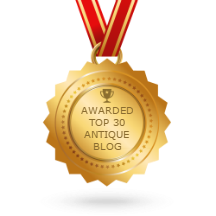There are some acronyms used a lot in the antique and custom furniture business that are good to know:
The first two are "COM" and "COL" and relate to fabric and leather that will be used on any antique or custom furniture you buy (assuming you're upholstering or reupholstering it).
They're important because you need to get just the right amount of material and if you're doing the upholstering in some gorgeous antiqued leather, boar hide, exotic sting ray shagreen (see below for definition), etc., it can really elevate a nice piece to a truly OMG piece.
Here's a close up of a 1930's shagreen and ivory box--the texture is almost pebbly like terrazzo and it's just so chic:

And shown below are some leathers hand-dyed and antiqued by C. Mariani. Again, look how rich a new leather can be made to look if treated properly.
This first one is our 22k gold gilded leather (and no, it doesn't rub off!):
And here is a moss green, umber and chocolate leather that's been hand-dyed after it's been upholstered on the antique (that's what creates the incredibly rich look):
And here is newly antiqued leather that is washed and rubbed down very heavily to create a faded look as if it's been in use for years:

Ok, so let's get to the jargon and see what it all means:
COM = "customer's own material". That means that the designer needs to provide the fabric that will be used to reupholster an antique or to upholster a new sofa/chair/etc. The custom furniture wholesaler (e.g., that would be me at C. Mariani) gives the designer the estimate of the yardage needed and then the designer orders it and has it delivered to us.
COL = "customer's own leather". This means exactly the same thing as COM except that the designer has decided to upholster/cover in leather and not fabric. The thing with leather is that it's not based on yardage off a bolt, it's based on square feet. So if you're quoted "one yard of COL leather, then the calculation would be 18 square feet (there are 18 sq feet in each usable yard of leather).
There's another tricky thing about COL - sometimes it's quoted in "hides" but the size of hides differ depending on the animal, so that makes it an issue that often causes problems/confusion. For example a cowhide is typically around 55 square feet per hide but you need to be careful to only measure the "usable" feet-because cows bump into fences and (sorry PETA) barbed wire and this can often make parts of a hide unusable. Here's what a typical cowhide looks like before we cut and dye it:

Also, if you're talking about a different animal like shagreen (pronounced SHUH green" and as I mentioned earlier it's typically stingray skins but can also be sharkskin. Shagreen was very popular in the Art Deco period as well as today. But the stingray, for example, comes in itsy bitsy hides that have usable areas of only about 12" in diameter. Here's a photo of four dyed shagreen hides (the two holes you see on each are where the (ick) eyes were! Again, sorry PETA:

How to get around this mind-bending "how much hide do I need" is to just request the COL to be quoted in "usable square footage" only and not in the more typical "number of hides" calculation. You'll save yourself a lot of grief that way.
Ok, next we have two shipping acronyms CIF and FOB. You'll see antiques and other pieces quoted "FOB", for example. What that means technically is "freight on board" but what the heck does that mean? It means YOU ARE PAYING THE FREIGHT AND INSURANCE. The seller says FOB when the price only includes the labor to get the piece ready for pick up on their dock. This is standard "in the trade". The trade also refers to FOB as WILL CALL-means the same thing.
CIF means "cost, insurance and freight included" and this is more of an old fashioned term of sale--but it's a great thing if you can get it!






1 comment:
I love shagreen...I can't seem to stop posting about it.
Post a Comment